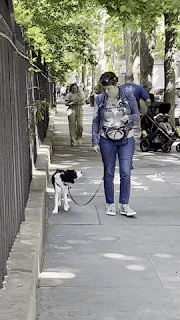Dog Days: Life in Lockdown with Olive & Mabel, by Andrew Cotter (Sourcebooks, 336 pp, 2022, $16.99) Review by Skye Anderson.
I've had this book for about a year, started it but didn't get very far until I picked it up again and am I glad I did! Actually I got sidetracked by viewing most of the 44 videos! (see below)
Dog Days: Life in Lockdown with Olive & Mabel is author Andrew Cotter's second book about life during COVID with Olive (black lab, 8) and Mabel (yellow lab, 4), his two very world-famous Scottish Labrador Retrievers who have entertained the world recently, starting with their daily life and non-antics during COVID depicted in short video snippets with accompanying hilarious non-stop commentary by their person, a COVID-underemployed sportscaster.
Sportscasters are known to get excited and talk lickity-split: Cotter does both in a Scottish accent to boot but he also writes like he speaks - fast with long sentences that I cannot read out loud in one breath. You can simply imagine his voice coming through the written words and laugh often as you read a book written as a diary over the course of a year.
Second Book, Amused and Confused
Dog Days starts in the middle of COVID and sees it to its finale, so I suspect Cotter's first book, Olive, Mabel and Me: Life and Adventures with Two Very Good Dogs, begins either before or at the start of COVID. Now I shall have to read Olive and report back if it's really necessary to begin at the beginning (shades of Julie Andrews!). I suspect not.
The Family and Its Environs
Olive, the elder, and Mabel, the younger and cover girl on Outside magazine, live with Andrew when he is home and not galivanting around the world covering international sports events in his Scottish lilt (or brogue). The world's best labs also live with the shadowy Caroline who is mentioned perhaps three times in the book so we can surmise she and Andrew are married. But the stars are, of course, Olive and Mabel.
As you read through, you come to know the stately worried Olive and the puppy-like Mabel. The written voice of their human grows on you and the color photos of the dogs being dogs in the middle of the book are, in British words, lovely, especially at the PGA championships and on stage, begging an audience for treats.
How It All Began
All of a sudden, sports events across the globe were cancelled so, with nothing to do, and two dogs to do it with, who wouldn't stage sporting events between the two laconic canines, video them and post them to the world. And do it again. And again. Forty-four times, to be exact.
But not all are narratives of the silent dogs looking and acting cute - like dogs. The author takes his dogs on hikes and camping trips up north. Unfortunately, this reviewer preferred the cute antics of the dogs at home with the creative repartee of their human - as far as she could understand the British vocabulary and references to people, places and things English (and Scottish).
The book's pages eventually and gradually depict the re-opening of society as COVID wanes and the author begins to write about more philosophical topics, like their hiking and camping trips.
The Bond
This reviewer was unable to divorce the book from the 44 videos but I do want to point out the relationship between man and dog(s) - the dogs stay close to him, follow him without leashes, gaze upon him with acute adoration. In like manner, the man teases his dogs with love-felt humor that keeps you coming back for more.
Video Episodes
1 The Dogs' Breakfast Grand Final
2 Game of Bones
3 The Walk of Shame
4 The Company Meeting
5 From the Sporting Archives
6 Mabel's Dream
7 Behind the Scenes
8 Not a Smooth Criminal
9 The Trust of Dogs
10 Intermission
11 Looking for Love
12 Run with Us
13 Home Help
14 Trick or Treat
15 Still Taking a Paws
16 Scent of a Dog
17 Exit the Stage
18 Home Gym
19 Lockdown Life
20 Card Game
21 Keeping Up Appearances
22 The Long Walk
23 Call of the Wild
24 Alternative Olympics
25 Co-authors
26 Squeak and I
27 The Inconstant Gardener
28 Escape to the Beach
29 Let Sleeping Dogs Lie
30 Their Master's Voice
31 World Dog Day
32 Sea Dogs
33 Just Being Dogs
34 Dogs of the Mountains
35 Once More to the Hills
36 Simple Dog Joy
37 Flora and Fauna
38 Butterfly Minds
39 Golf
40 Working Like a Dog
41 Mabel's Free Solo
42 Puppy Love
43 Ear-Flap Beach
44 Non-Gardener's World










